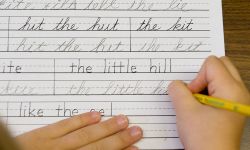Michigan school M-STEP scores down sharply from pre-pandemic testing

- The percentage of students proficient in math and English this year generally fell compared to pre-pandemic
- M-STEP scores can have huge impacts on low-performing students and schools and on teacher evaluations
- The results underscore other studies showing that students in remote classrooms generally fared worse
Scores on Michigan’s standardized test are sharply down from before the pandemic, underlining the severe academic toll of virtual learning and other COVID-related disruptions and traumas.
Last spring, 41.5 percent of third-graders statewide scored at least proficient in math on the exam, known as the M-STEP. That’s a decline of 5.2 percentage points from 2019, the last time the test was given before COVID-19 shuttered classrooms.
In English language arts, 41.6 percent of third-graders scored proficient or higher, a decline of 3.5 points from 2019.
With participation in the test returning to normal this spring, the results are among the strongest evidence available of the academic fallout from the pandemic.
Reading:
- Michigan’s 3rd-grade reading scores show the cost of remote COVID learning
- Math, reading scores plummet on national test, erasing 20 years of progress
- Critical race theory flap makes teachers tiptoe on slavery, racism topics
“This year’s results indicate that Michigan students are still performing below pre-pandemic levels — with persistent and troubling opportunity gaps for our most underserved students,” said Amber Arellano, executive director of the Education Trust-Midwest, a nonprofit education advocacy group, in a statement. She noted that Michigan has been “behind our peers across the nation for far too long, and long before the pandemic.”
The scores have high stakes for the lowest-scoring students and schools. About 6 percent of third-graders will be recommended for retention under Michigan’s Read by Grade Three law based on their English skills, though less than half of students targeted for retention have been made to repeat third grade in years’ past.
The scores also play a major role in teacher evaluations and in the letter grades that the state gives to each school. And the most academically troubled districts will be put under increased state scrutiny, known as a partnership agreement, that can lead to a takeover or closure if scores don’t improve.
The results also underscore research showing Michigan students learned less in virtual settings during the pandemic. Though many districts that rarely or never resorted to remote classes saw declines, districts that offered the most remote instruction saw some of the biggest drops in scores.
In districts with at least 50 third graders, 127 districts saw English Language Arts scores fall by 10 percentage points or more compared to 2018-2019.
Of those, 22 percent — or 28 districts — were fully remote for four months or more during the 2020-21 school year while 54 percent were fully remote for just one month or none. Of the 37 districts to record gains of 10 percentage points or more, just two were remote for four months, or 5 percent. Far more — 70 percent or 26 districts — were remote just one month or not at all.
Amid growing concerns about students’ academic well-being, Michigan schools are spending billions of dollars in federal COVID-19 relief to address the academic and emotional impacts of the pandemic. Many educators say the toll would be much worse if not for that additional federal funding, which expires in 2024. This year, they’ll be further aided by a record state education budget that includes extra funding for low-income students and for teacher recruitment and retention.
Schools were required to give the M-STEP in 2020-21, but parents worried about COVID-19 were allowed to opt out. Many did so, and just 70 percent of students took the test compared to 95 percent this year, a figure in line with the historical average. Experts noted that comparing statewide results year-to-year doesn’t work when participation rates differ so widely.
Nationally, students are also suffering significant academic losses. The National Center for Education Statistics released nationwide results Thursday of reading and math scores on the NAEP, a test often referred to as the “the nation’s report card.” Reading scores dropped more than they have in over 30 years and math scores dropped for the first time since the test first began in the early 1970s.
Students that skipped the Michigan exam last year typically belonged to groups that faced the greatest challenges during the pandemic, including students who had spent the year learning online, students of color, economically disadvantaged students and English language learners, state Superintendent Michael Rice said. With the inclusion of those historically lower-scoring students this year, it is perhaps unsurprising that statewide scores fell in most grade and content areas compared to last year.
Responding to the new test data, Rice said new investments are needed in evidence-based policies such as smaller class sizes, in-depth professional development, tutoring, and small-group instruction.
“Each of these things has a disproportionately greater benefit for those who need than for those who don’t,” he told Chalkbeat. “They have a disproportionately favorable impact on at-risk children than middle-class children.”
In the Detroit Public Schools Community District, Michigan’s largest, officials have set aside a portion of COVID dollars for small group and one-on-one literacy tutoring for students several grades or more below reading level. The district’s scores remain well behind pre-pandemic levels, suggesting a long road ahead. Detroit Superintendent Nikolai Vitti pointed to the various COVID-related disruptions of student learning during the 2021-22 school year as well as chronic absenteeism as playing significant factors on last spring’s test scores.
The trauma of the pandemic, combined with dark headlines about climate change and school shootings, offer one explanation for falling scores, said Elizabeth Moje, dean of the School of Education at the University of Michigan.
“They’re looking around and going, ‘Gosh, the world is crumbling around us.’ There’s all this violence. How about school shootings? These are young people who are trying to make sense of their place in the world and asking ‘Where do I fit?’ and they’re being asked to learn abstract things that they don’t understand the purpose for learning. That in itself is stress-inducing.”
Testing experts cautioned against using the exam scores to draw conclusions about how schools performed during the pandemic given how much classroom time students missed.
“The word I would use is ‘grace,’” said Ed Roeber, assessment director for the Michigan Assessment Consortium, a nonpartisan education group. “There were a whole lot of people putting in 110 percent effort in getting kids taught.”
He said schools have the tools to accelerate student learning now that children are back at school. They can reduce class sizes, for example, or double check that every student is taught all the key concepts that show up on the test.
“Every child who’s tested can achieve proficiency,” he said. Schools can help them do so “not by practicing the test items but by looking at their instructional program and saying, ‘What kinds of skills do kids need to have?’”
At Westwood Community School District in Dearborn Heights, Superintendent Stiles Simmons said helping students recover includes both academic support and social, emotional support. His district is expanding a mentorship program it started last year for middle school students. He credits pandemic relief money for being able to hire a districtwide social emotional learning coordinator, who he said “has been a godsend.”
He said the M-STEP data can serve as a “baseline” and can be a “good exercise for maybe research purposes, but it doesn’t necessarily help us long term.“
“We need to really look at where we are now because that’s where our kids are,” he said.
In the Reeths-Puffer School District near Muskegon, 2021 scores dipped but have now returned to pre-pandemic levels for most grade levels for English language arts and in elementary grades for math. The district enrolls about 3,500 students, more than half of whom are considered economically disadvantaged by the state.
“I would say we’ve stayed relatively consistent through the pandemic,” Superintendent Steve Edwards said. “If you didn’t regress during the pandemic, I guess you can count that as a small win.”
He said he believes two factors contributed to that: the district’s decision to remain in-person for all of 2020-21, and its $500,000 investment in summer acceleration programming over the last two years. That funding came from federal COVID relief money that will run out in September 2024.
The pandemic funds provided “an immediate shot in the arm, but it could be detrimental to build systems and supports that people come to rely on, that then are no longer funded,” he said. “In the short term it’s great, but in the long term it makes me nervous.”
Brooke Brawley, director of curriculum, instruction and assessment at Niles Community Schools, said the testing information is helpful in determining what extra supports students need. But she said it’s important to remember these scores are only one data point among many that inform teachers on students’ academic levels.
She said one area for growth would be looking at math scores and seeing how to use multi-tier systems to help students improve. A multi-tier system includes curriculum for all students with additional supports for students who need them.
Simmons, of Westwood, agreed. He said his district tends to focus more attention on benchmark tests that are administered three times a year since they provide more real-time data of where students stand.
He expects to receive a comprehensive report from one of his employees Friday about how the district did. From there, he wants to analyze how the district compares to similar districts in size and demographics.
The district used benchmark scores last school year to determine who should receive high dosage tutoring. Simmons said students who regularly attended tutoring sessions had better grades and better benchmark test scores. He said the district is considering working with companies that have strong after school tutoring programs as well.
For Frances Vicioso, a parent of a Kalamazoo Public Schools graduate, the district’s results are very “concerning” but it’s “absolutely what I expected.”
She wants more equitable school funding, more accessible information for parents about the school district’s budget and more understanding from others about the limitations of standardized testing.
One-third of Kalamazoo Public Schools third-grade students were proficient or higher in English Language Arts while 30.7 percent of third-grade students were proficient or higher in math.
Kalamazoo’s third grade English language scores remained lower than the state average and had similarly sized drops as the state when comparing 2018-2019 to 2021-2022. In third grade math, however, the district's scores fell 7 percentage points, from 37.5 to 30.7 percent, compared to the 5 percentage point drop statewide (from 46.7 percent to 41.5 percent).
The district was fully remote for nine months during the 2020-2021 school year.
Vicioso, a former middle school teacher, said students’ achievement can be measured in other ways including verbal reflections, class participation and projects.
Vicioso is the co-director of Truth, Racial Healing & Transformation Kalamazoo, an initiative that works to provide accurate historical narratives, build strong relationships and advocate for systemic change. She said she is concerned about many local students including economically disadvantaged students and Black and brown students.
“It tracks that the lack of services and lack of support would be reflected in these M-STEP scores,” she said.
Koby Levin is a reporter for Chalkbeat Detroit covering K-12 schools and early childhood education. Contact Koby at klevin@chalkbeat.org.
Isabel Lohman covers education for Bridge Michigan. You can reach her at ilohman@bridgemi.com.
Tracie Mauriello covers state education policy for Chalkbeat Detroit and Bridge Michigan. Reach her at tmauriello@chalkbeat.org.
Michigan Education Watch
Michigan Education Watch is made possible by generous financial support from:
Subscribe to Michigan Education Watch
See what new members are saying about why they donated to Bridge Michigan:
- “In order for this information to be accurate and unbiased it must be underwritten by its readers, not by special interests.” - Larry S.
- “Not many other media sources report on the topics Bridge does.” - Susan B.
- “Your journalism is outstanding and rare these days.” - Mark S.
If you want to ensure the future of nonpartisan, nonprofit Michigan journalism, please become a member today. You, too, will be asked why you donated and maybe we'll feature your quote next time!






